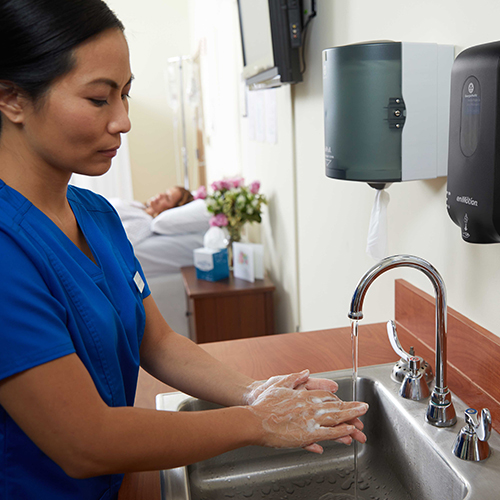Back to All News and Knowledge

Infection Prevention: How Hospitals Promote Healthy Behaviors in Their Communities
Every year as we enter the peak of flu season, communities meet a frenzy of infection prevention and control (IPC) reminders from news outlets, schools and social media posts. While these modes of education and empowerment are necessary and aid preventative practices, the power of hospitals as centers of community wellness should not be underestimated. Role modeling on hand hygiene and environmental cleanliness within the hospital can empower patients to continue these healthy behaviors in their communities and at home.We often link hospital influence with the latest technological advances or major surgeries performed. Sometimes, however, the smaller and more personal staff-patient interactions can create just as significant an impact within the patient’s community.
Back to Basics
For hospitals striving to become more effective community influencers, advice might include going back to hygiene basics. Constant contact between staff and patients will persist within hospitals and other healthcare facilities. Consider, however, a basic protocol as important as hand hygiene. While handwashing between patient visits may seem like a common practice, one study reported that only 40% of healthcare workers adhere to effective handwashing techniques.1 In addition, glove use is often an erroneous reason for the omission of hand hygiene before donning and doffing gloves.According to the 2019 CDC report, “Antibiotic Resistance Threats in the United States,” more than 2.8 million antibiotic-resistant infections occur in the U.S. each year, and more than 35,000 people die as a result.2 Furthermore, the report states that hand hygiene is a proven intervention to prevent the spread. With such high rates of infection transmission, it is important to find ways to help ensure that all healthcare workers exercise good hand hygiene. According to the World Health Organization, the likelihood of staff engagement and sustained improvement in hand hygiene includes a sound infrastructure3 of soap and sanitizer dispensing systems, which may include automated methods to monitor performance.
Environmental Cleanliness
Environmental Services also have a big impact on health and hygiene. Contaminated care environments can be a major source for contracting HAIs. Bacteria and viruses can live on surfaces for several hours, even months, depending on the pathogen.4 Therefore, hard surfaces and even soft surfaces, such as bedding and curtains, must be cleaned or replaced consistently by the environmental services staff. Routine cleaning and disinfection protocols in patient rooms and around the hospital not only keep the rooms looking nice but may also demonstrate for patients and their families the importance of disinfecting and cleaning all surfaces, including electronic screens, furniture and countertops.Contamination of surfaces in intensive care unit (ICU) rooms have also been identified as major points of contact in cross-transmission of pathogens among critically ill patients.5 While EVS workers typically do not interact with patients like nurses and doctors, they are role modeling cleaning procedures and techniques while in the patient room.
From Illness to Community Wellness
By role modeling hand hygiene and cleaning routines, patients and their families can adopt self-sufficient behaviors that extend past the walls of the hospital. These learned, healthy behaviors can be practiced by the community, creating a relationship built on trust between hospitals and the people they serve. When effectively engaged, community members have a hand in their own health and recovery.
Sources:
1Erasmus, V., et al., (2010) Systematic Review of Studies on Compliance on Hand Hygiene Guidelines in Hospital Care. Infection Control & Hospital Epidemiology, 31: pp 283-294, https://www.cambridge.org/core/journals/infection-control-and-hospital-epidemiology/article/systematic-review-of-studies-on-compliance-with-hand-hygiene-guidelines-in-hospital-care/36AD78694A4A2BA831A598E9C935C922Centers for Disease Control and Prevention, (2019) Antibiotic Resistance Threats in the United States. U.S. Department of Health and Human Services, p 7, https://www.cdc.gov/drugresistance/pdf/threats-report/2019-ar-threats-report-508.pdf.
3World Health Organization & WHO Patient Safety, (2009) A guide to the implementation of the WHO multimodal hand hygiene improvement strategy. World Health Organization, p 8, http://www.who.int/gpsc/5may/Guide_to_Implementation.pdf
4Steckelberg, J., (2020) How long do cold and flu viruses stay alive after infected people cough or sneeze? Mayo Clinic, https://www.mayoclinic.org/diseases-conditions/flu/expert-answers/infectious-disease/faq-20057907
5Seki, M., et al., (2013) Nosocomial outbreak of multidrug-resistant Pseudomonas aeruginosa caused by damaged transesophageal echocardiogram probe used in cardiovascular surgical operations. Journal of Infection and Chemotherapy, 19: pp 677-681, https://www.ncbi.nlm.nih.gov/pubmed/23292134
Back to All News and Knowledge
